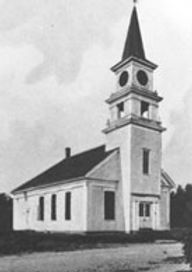Church on the Cape - United Methodist
A community church in Cape Porpoise, Maine
The Beginnings of the Church on the Cape
The first church was erected in 1727 on the corner where Route 9 swings into the Mills Road. Here, for the next thirty years, the religious affairs of the community were served. However, as the years passed by, the western part of the town along the river had increased in population faster than the Cape. Therefore, calls were made to change the location of the church to a more central position. When this motion was defeated, drastic measures were initiated.
On the night of April 28, 1763, some men from the western sector persuaded two boys to set fire to the Cape church. The building was totally destroyed. The boys were soon found out yet were not prosecuted for it was realized that the real blame rested with those men who had directed them. Thus, the major controversy involved where the new church was to be built. Following the recommendation of a special town meeting and a committee of three disinterested men, two from Saco and one from Wells, it was decided to build on Burbank’s Hill.
This site is where the present First Congregational Church now stands in the Town House section of Kennebunkport. The residents of the eastern part of the Cape were vehemently opposed to this arrangement, but it was clear that the Cape had lost the ascendancy it once held in town affairs. In its indignation, the Cape ceased to be actively involved with the church until the Methodist Conference took an interest in the area around the year 1810.
By the year 1820, the nucleus of a future congregation had been formed in Cape Porpoise. Lacking the numbers to establish a separate church, converts to the Methodist Conference met in private homes or in the schoolhouse and were accepted as members of the church at the Port village. Until a new church could be built, services at the Cape were held on Saturday nights.
It was in the summer of 1856 when George Fletcher, Thatcher Hutchins, and Joseph Huff, the trustees of the “Church on the Cape,” borrowed $400 from James Huff in order to purchase the land and lumber necessary to erect a church building. The building lot was purchased from George Wakefield.
By April 1857, the building had been completed, and on the 30th day of that month, William Farrington preached the dedication sermon. Reverend John Collins was the minister.
Within a short time, the trustees met and paid back the money and interest borrowed from James Huff. The finished church, without vestry, steeple, clock, or bell, had cost $1,500.

Our church before the
steeple was added

Steeple was added in 1902
Little change was made to the building until 1898. In that year the vestry was added. The steeple was completed in November 1902, and the bell was donated in that same year by a summer resident, Mr. Frank A. Allen. It was rung for the first time on November 19, 1902. The church clock was added in 1910. Mr. Allen is said to have made a generous gift towards the $660 cost of the clock, but a part of the money was also raised by public subscription. The clock first sounded over Cape Porpoise on October 22, 1910.
In September 1956, the adjoining land to the church was bought from the heirs of Arthur Nunan. This land was cleared, and in 1960 was the site on which the ladies’ parlor was constructed. In that same year, additional Sunday School classrooms were built upstairs.
Changing demographics led to a gradual decline in church attendance and activity in the ensuing years. But in 1993 a bold decision was made to attempt to bring the church back to its original vitality. Recognizing its traditional role as the source of community inspiration, the congregation reached out to all those who called this town home whether year round or for a season.
They drew upon the abilities, time and talents of those with widely ranging backgrounds and experiences. Together a new church evolved, with native and newcomer alike sharing their sense of community and spirituality.
An addition was added in 1994, which housed the office, pastor’s office, and Cargo Shop. Another addition and many improvements were finished in the fall of 2007, including moving the offices, adding an elevator, a full kitchen, music room, more Sunday School space and the Carl G. Bartlett fellowship Hall. Our church continues to gather a congregation unequaled in ability and enthusiasm.
